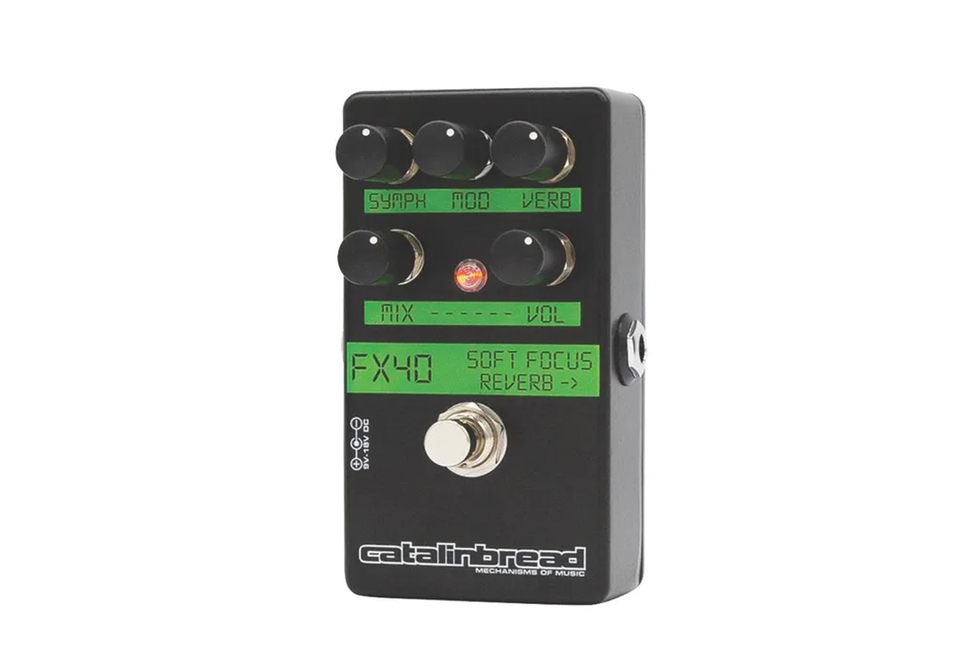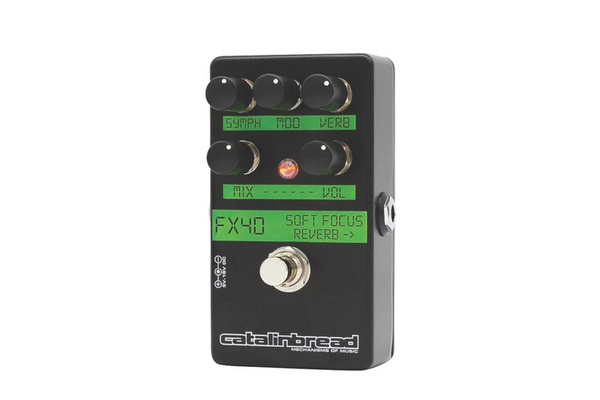If there is a prettiest work in the shoegaze canon, Slowdive’s Souvlaki is arguably the one. Souvlaki is probably also the reason the Catalinbread FX-40 Soft Focus exists. The FX-40 Soft Focus, you see, is inspired by the sounds of the “Soft Focus” preset on the Yamaha FX500, a still-inexpensive multi-effects unit that debuted in the waning days of the 1980s. Though definitive documentation about when Slowdive used the FX500 is spotty, guitarists Neil Halstead and Christian Savill have both alluded to using it. As Slowdive enjoyed an unexpected renaissance over the last decade, word got around among curious guitarists that the FX500, and the Soft Focus preset in particular, might have been responsible for Souvlaki’s highly intoxicating, dream-picture textures.
Speculation about tone sources on records—which are inevitably colored by other outboard processors—is risky business. Yet there is much about the Yamaha’s Soft Focus preset that is eerily redolent of Slowdive’s sleepy and soaring washes of reverb. (And yes—as a major, OG Slowdive fan I have tried it out myself.) Catalinbread’s FX-40 Soft Focus pedal takes a few liberties with recreating the Yamaha preset. It removes the Yamaha preset’s redundant delay component. Catalinbread also says they used a plate reverb algorithm as a starting point. (There is no indication in the original FX500 manual of what kind of reverb Yamaha intended the Soft Focus to be.)
”The ease with which you shape variations on celestial textures is a delight.“
So, while the Catalinbread Soft Focus may be more an interpretation of the FX500 Soft Focus preset than a to-the-letter emulation, it effortlessly conjures sounds that can lend a Souvlaki-like and ethereal essence to your own compositions, as well as reverb tonalities that can lead you along very non-shoegaze tangents.
Diagram of a Dream
One of the most appealing facets of the FX-40 design is its simplicity. Compared to clunky late-’80s rack units, it is downright dainty. And though it’s far from the only compact stompbox capable of deep, ambient reverbs, few are as singularly dedicated to the pursuit of that sound. And the ease with which you shape variations on those celestial textures is a delight.
Even if you’ve never explored reverb much beyond amplifier-based varieties, the FX-40 is easy to suss. “Verb” governs decay time. The cool volume control adds gain to your dry signal before it hits the reverb. “Symph” adds in an octave-up signal. Catalinbread calls the octave effect subtle in their documentation, but, to my ear, the octave-up content in the FX-40’s signal still comes on pretty strong. The modulation control governs the rate of an onboard chorus. And as with many chorus effects, the peaks in modulation can emphasize specific frequencies and harmonics—particularly in the octave-up voice—that radically shift the profile of the reverb, especially when you add a long tail.
Stumbling Toward Slumberland
Unlike a lot of records in the shoegaze genre, Souvlaki is not a monolith of reverb wash. It percolates with different guitar textures—some drier, some soaked. I’d even venture that what a lot of people perceive as octave’d reverb on the guitars is actually Rachell Goswell’s beautiful, swirling vocals. It’s a lovely production. But while many guitar tones on Souvlaki are colored with octave-up content—particularly the simple melodic lines—my own efforts to replicate these sounds revealed that a little octave-up content from the FX-40 goes a long way, and that aggressive-but-just-right decay times and a little modulation were most critical to nailing those tones. Adding distortion and overdrive, incidentally, has a way of softening and gluing together some of the more inorganic elements of the octave-up sound.
If you’re more interested in crafting original tones, the relationship between the octave-up “symph” voice and the modulation gives you a lot of ground to explore. Adding the latter can exaggerate the former. (Think about how a human voice with intense vibrato tends to stand out over a straight-toned voice.) I’m not generally a fan of excessive octave-up reverb. In contemporary ambient and shoegaze music it has almost become the equivalent of high-fructose corn syrup. But on the FX-40 you can very easily steer clear of those pitfalls by dialing the octave back and letting the long decay do the heavy lifting.
The Verdict
Much of the guitar universe (including a few folks that sound suspiciously like they heard their first Slowdive record last week) fell over itself to anoint the FX-40 Soft Focus as the reigning shoegaze-in-a-box king. But while I would happily recommend this pedal to anyone chasing that kind of ambience, Catalinbread sells itself a little short by so strongly emphasizing it as such. The FX-40 Soft Focus is capable of weird and ghostly short-to-medium-decay-range tones, and truly complex, drier reverb tones. Operation is intuitive and fun. If you only want reverb tones that evoke the sounds of Souvlaki, there are cheaper paths to that goal. But if your musical agenda leaves you open to exploring the breadth of this cool pedal’s possibilities, the $209 price will be a fair one for this lovingly designed, U.S.-built pedal.
Catalinbread Soft Focus Reverb Demo | PG Plays
Catalinbread Soft Focus Shoegaze Reverb Pedal with Chorus, Modulation, and Octave-up






















